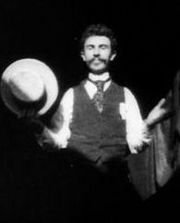William Kennedy Dickson facts for kids
Quick facts for kids
William Kennedy Dickson
|
|
|---|---|

A scene from the 1891 film Dickson Greeting. This was the first American film shown to a public audience.
|
|
| Born |
William Kennedy Laurie Dickson
3 August 1860 Le Minihic-sur-Rance, Brittany, France
|
| Died | 28 September 1935 (aged 75) Twickenham, Middlesex, England
|
| Occupation |
|
William Kennedy Laurie Dickson (born August 3, 1860 – died September 28, 1935) was a British inventor. He helped create one of the first movie cameras while working for Thomas Edison. Dickson played a very important part in the early days of filmmaking.
Contents
Early Life of William Dickson
William Kennedy Dickson was born on August 3, 1860. His birthplace was Le Minihic-sur-Rance in France. His mother was Elizabeth Kennedy-Laurie. His father, James Waite Dickson, was a Scottish artist.
In 1879, when William was 19, he wrote to the famous American inventor Thomas Edison. He wanted to work for Edison, but he was not hired at first. That same year, William, his mother, and his two sisters moved from Britain to Virginia. Finally, in 1883, Edison hired him to work at his laboratory in Menlo Park, New Jersey.
Creating the First Movie Cameras
In 1888, Thomas Edison had an idea. He wanted to invent a machine that could do for the eyes what the phonograph did for the ears. The phonograph recorded sound. Edison imagined a device that could record moving pictures. He called this new invention the Kinetoscope.
William Dickson was Edison's main photographer. He was given the job of making Edison's idea real. At first, they tried to record tiny pictures onto a cylinder. But in 1889, Edison decided to try something different. He told his team to use rolls of film instead.
Dickson worked with the Eastman company to make a special celluloid film for this purpose. They first used 19mm film, which moved sideways and made round pictures. But Dickson eventually chose 35mm film. This film size, with a 1.33:1 picture ratio, is still used in movies today.
Developing the Kinetoscope
William Dickson and his team also worked on the Kinetoscope viewing machine. This machine would show the films they made. The first working model, using 19mm film, was shown in May 1891. It was shown to a group of women's clubs.
By late 1892, the 35mm camera was mostly finished. The complete 35mm Kinetoscope was shown to the public on May 9, 1893. This happened at the Brooklyn Institute of Arts and Sciences.
Dickson's team created the illusion of movement. They did this by moving the film strip continuously. The film had many pictures in a row. A quick flash of light would shine through a spinning shutter. This made the pictures seem to move.
They also invented the Kinetograph. This was a motion picture camera used to film movies. It could film up to 46 pictures per second. To make the film move smoothly, they used a special system. This system allowed each picture to stop long enough to be recorded. Then, it quickly moved to the next picture. This stop-and-go film movement was key for filmmaking for the next 100 years.
Working with Other Inventors
In 1894 or 1895, William Dickson started helping the Latham brothers. They ran a company that showed Kinetoscope films. The Lathams wanted to create a movie projector. They hired Eugene Lauste, another former Edison worker. Dickson likely suggested hiring him.
In April 1895, Dickson left Edison's company. He helped the Latham group. He might have helped create something called the Latham loop. This invention allowed much longer films to be made and shown. This idea had actually been shared earlier, in 1890, by William Friese-Greene.
These former Edison workers helped design the Eidoloscope projector system. They also created a widescreen camera. This system was used for the first public movie showing in history on May 20, 1895.
But Dickson soon left the Latham group. He joined a new company called the American Mutoscope and Biograph Company. In 1897, he moved back to the United Kingdom to work for the British part of this company. William Dickson was the first person to film the Pope. His Biograph camera was even blessed by Pope Leo XIII.
The Mutoscope machines showed moving pictures using a spinning drum of photos. It was like a flip-book. These machines were often found at seaside places.
Later Life and Legacy
William Dickson's work with Biograph ended in 1911. He spent his final years living quietly in Twickenham, England. He passed away on September 28, 1935, at age 75.
For a long time, Dickson did not get enough credit for his important work in film history. But later research by Gordon Hendricks and Paul Spehr showed how much he truly helped create moving pictures.
Dickson was the first to direct a film with live sound. In 1894, he directed The Dickson Experimental Sound Film. In this film, a man (likely Dickson himself) played a song on the violin. The sound was recorded by a phonograph. This film was the first to use the Kinetophone. This was the first device used for early sound films.
See also
 In Spanish: William Kennedy Dickson para niños
In Spanish: William Kennedy Dickson para niños- The Dickson Experimental Sound Film
- Blacksmith Scene
- Fred Ott's Sneeze
- Edison's Black Maria
- List of William Kennedy Dickson films

